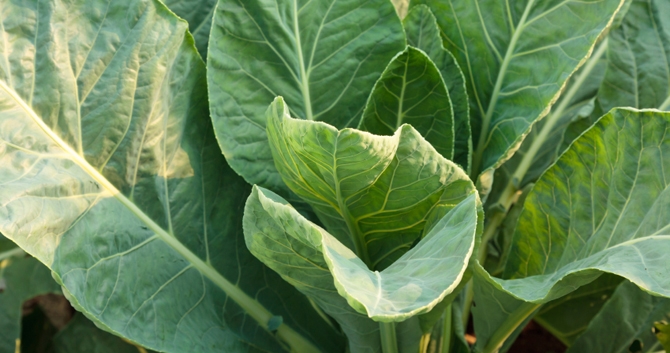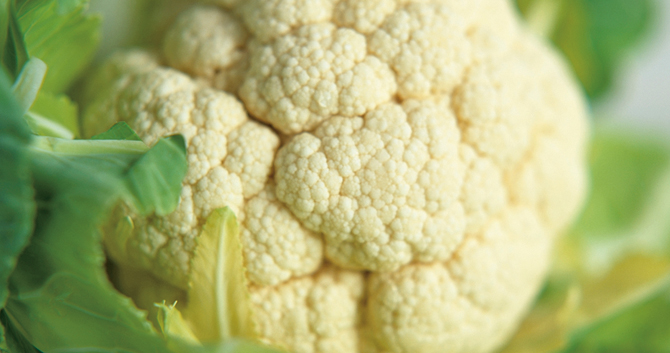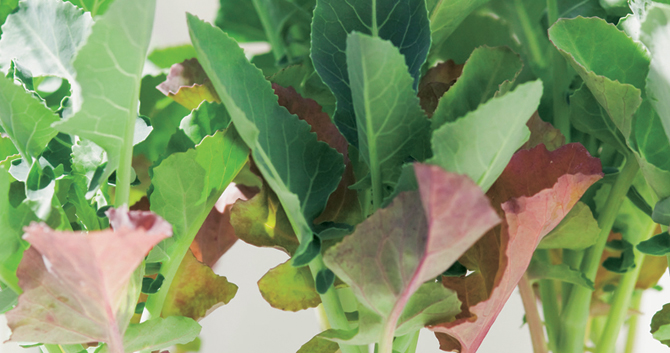Mark Twain once famously quipped that “Cauliflower is nothing but cabbage with a college education.” Although it's true that cauliflower descended from wild cabbage and was carefully cultivated to form large snowy heads, there’s a lot more to cauliflower than a botany degree!
Packed with health benefits, this crisp, versatile vegetable is delicious eaten raw, gently steamed, roasted in olive oil, grilled, mashed or pickled, not to mention baked in cheese sauce to blissful perfection.
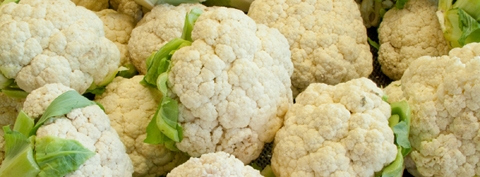 Cauliflower descended from wild cabbage, carefully cultivated to create snowy heads
Cauliflower descended from wild cabbage, carefully cultivated to create snowy heads
Originally from the Mediterranean, cauliflower is a member of the Brassicaceae family, along with broccoli, cabbage, Brussels sprouts, kale, collards, turnip and rutabagas. If you look closely at the open flowers of these plants, you’ll notice they resemble small four-petaled crosses, earning them the name crucifers or cruciferous, meaning cross.
When it comes to cauliflower, comparisons to broccoli are inevitable. Beyond the obvious differences in color and taste, they also have very different growing habits. Broccoli grows upwards and outwards, forming bunches of tiny green florets. Cauliflower, on the other hand, is a dense, compact head formed from the undeveloped flower buds of a cabbage plant.
Types of Cauliflower:
We all know that cauliflower is white...or is it? Today’s varieties include a few colorful surprises – like orange, purple, and green in addition to the familiar white cauliflower we all know and love. Although colors vary, the mild nutty taste is similar among the assorted varieties.
White varieties are the most widely recognized. The heads form with the classic snowy white color because they are protected from the sun by the outer leaves. Choose self-blanching varieties or plan to tie up the leaves to blanch them as the plants develop.
Orange cauliflower first emerged on the scene in 1970 when it was discovered growing in a marsh near Toronto, Canada. The secret to this unusual variety is extra beta-carotene, the same compound that gives carrots their signature orange color. Mild tasting and sweeter than traditional white varieties, the color becomes even more pronounced when cooked. As an added bonus, it contains 25 times more vitamin A levels than other cauliflower varieties.
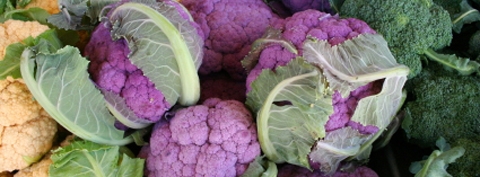 In addition to white, cauliflower comes in purple, orange and green varieties
In addition to white, cauliflower comes in purple, orange and green varieties
Purple cauliflower is another unique variation that adds a colorful twist to your favorite recipes. Purple varieties get their color from anthocyanin, an antioxidant similar to that found in red cabbage. Similar in taste to white varieties but somewhat milder and sweeter without the bitterness. The purple color is water soluble and will turn green when cooked unless you add a little vinegar or lemon juice to the water to “fix” the color.
Green varieties, also known as “broccoflower”, have a lime green head that retains the texture and density of a classic cauliflower head, but with the chlorophyll of broccoli. This blend between broccoli and cauliflower is more cauliflower than broccoli, with a sweeter flavor than both.
Getting Started
A little preparation before planting your cauliflower will simplify care and maximize results. When choosing a location, keep in mind that cauliflower needs 4 to 5 hours a day of sunlight. Remember that trees may not have all their leaves in early spring when you’re selecting your garden site, and plan ahead to avoid areas that will be shaded later in the season.
Unlike many other garden plants, cauliflower prefers dense soil so you’ll want to start preparing their spot early to give it time to settle before planting. About six weeks before planting, remove debris and loosen the soil, breaking up any clumps that are larger than an apple. Add compost or other organic garden mix to provide nutrients for healthy growth.
Cauliflower needs regular watering to keep soil moist but not soggy. When selecting the location for your cauliflower, be sure the hose or sprinkler is within easy reach.
Care Tips
Cauliflower is a worthwhile addition to your garden, and with just a little care and attention it will reward you with an abundant harvest. It prefers cool temperatures, so plant early to allow time for a summer crop to mature before the summer heat. Alternatively, plant in mid-summer for a later harvest during fall’s cooler weather.
Planting: Cauliflower needs plenty of room to grow. Space young plants 18 inches apart and leave 2 to 3 feet between rows of plants to give you room to maneuver for weeding and harvesting. If the plants seem a bit floppy and lanky when you’re transplanting, pick off the lower leaves and plant slightly deeper. The buried lower stem will help promote sturdier stalks.
Watering: Cauliflower does not have deep roots, so it’s important to keep the garden soil evenly moist. Check the soil weekly—more frequently during hot, dry or windy weather--and irrigate as needed to be sure the soil doesn’t dry out. If cauliflower roots are deprived of water for even a short time, the heads may not form.
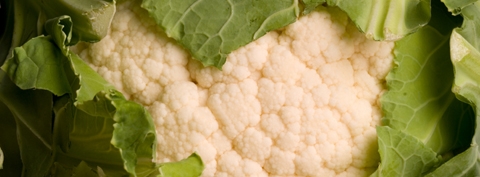 Cauliflower must be blanched to keep the head white
Cauliflower must be blanched to keep the head white
Mulching: Further promote uniform soil moisture and reduce weeds by applying 2-3 inches of mulch between the rows, keeping mulch a few inches away from plant stems. This also helps keep the soil cool and promote healthy development of the cauliflower heads.
Fertilizing: Once plants are established, fertilize with a time-release granular top-dressing or regular applications of a water soluble product formulated for vegetables. Follow package instructions carefully for best results.
Harvesting
Cauliflower takes about 55 to 80 days to mature, depending on the variety. It can be picked once the head has reached about 6 inches in diameter and is firm and compact with tightly clustered flowers.
Don’t delay your harvest hoping for a gigantic head! When cauliflower is left on the plant too long, its sugars develop into a type of fiber called lignin, creating stems that will be tough no matter how long the cooking process. It may also begin to flower at which point it develops an unpalatable bitter taste.
To harvest your cauliflower, simply cut the head at its base, retaining a few of the outer leaves to protect the tender head. Plants may be pulled and composted at this stage.
Companion Plants
Take advantage of plants that grow well with cauliflower to deter pests, enhance flavor, encourage growth, or improve health. The following plants are good choices:
- Vegetables: Certain plants like celery, potatoes, and onions improve the flavor of cauliflower when planted nearby. Beets also make a good neighbor, requiring little of the calcium cauliflower needs to grow.
- Herbs: Aromatic herbs like basil, dill, mint, rosemary, sage and thyme help deter pests.
- Flowers: Repel aphids by planting cauliflower with marigolds or divert their attention with nasturtiums, which they prefer over cauliflower. Trap cabbage worms with geraniums.
Several edibles share space well with cauliflower, using the garden plot to full advantage. Use the space between your cauliflower plants to tuck in the following:
Spinach, loose-leaf lettuce and arugula stay fairly small, and grow better in the heat of summer when shaded by cauliflower leaves.
Radishes and garlic also grow well with cauliflower.
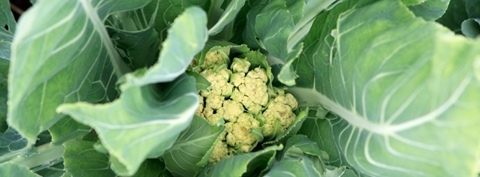 Cauliflower is ready to harvest when head are 6 inches in diameter
Cauliflower is ready to harvest when head are 6 inches in diameter
Conversely, there are a number of plants that don’t make good neighbors for cauliflower, competing for nutrients or attracting unwanted pests. Steer clear of planting any of the following too close to cauliflower:
- Tomatoes inhibit cauliflower’s growth. Both require lots of calcium for healthy growth and compete with each other for this important nutrient.
- Strawberries negatively affect the growth and flavor of cauliflower.
- Pole beans, mustards, and peppers also make poor companions for cauliflower.
Troubleshooting
There are generally few problems with growing cauliflower, but it’s helpful to be alert for those that could come up. If growing conditions are less than ideal, plants can become stressed and struggle to thrive.
Buttoning: If you notice the plant and head look stunted, it was probably stressed by too much heat, not enough water, or lack of nutrients. Keep plants well watered and fertilize regularly to avoid this. You can still eat what’s there, but once buttoning occurs, you can’t nurse plants out of the condition and get them to resume growth.
Bolting: Extreme swings of cold or heat, or allowing the soil to dry out too much can cause premature flowering (aka bolting). Hot weather may accelerate bolting so keep a watchful eye on the crop and harvest sooner if necessary.
Bitterness: Cauliflower heads need protection from the sun to avoid developing a bitter flavor. This can be remedied by blanching young plants when buds are small (See Sidebar).
Leaves in the Heads: Water stress and heat can cause leaves to grow through the heads. Keep plants well watered and fertilize regularly to prevent this problem.


